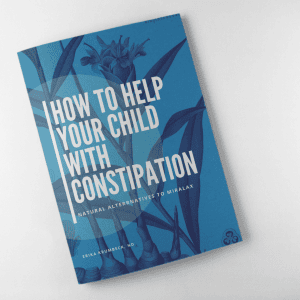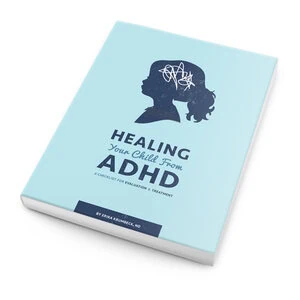Why do children need so much calcium? What do naturopathic doctors use calcium for?
Are you a healthcare provider? Read our research summary of calcium on Naturopathic Pediatrics PRO, our website for professionals.
Calcium is the most abundant mineral in the human body. Roughly 99% of it is stored in bones and teeth, while the remaining 1% circulates in extracellular fluid like blood and soft tissues. Its importance goes far beyond skeletal health: calcium regulates heart rhythm, nerve signaling, muscle contractions, blood clotting, and the activation of certain enzymes.
The body maintains a tightly regulated balance of calcium in the bloodstream, controlled by hormones like parathyroid hormone (PTH) and calcitonin. When blood calcium levels dip too low, PTH stimulates the release of calcium from bone and decreases calcium loss in the urine. Once calcium is restored, calcitonin helps curb further release and encourages urinary excretion. Because the body will always prioritize blood calcium over bone calcium, it’s essential to get enough calcium from food to protect long-term skeletal health.
Calcium-Rich Foods
Calcium is found in a variety of both animal and plant foods:
- Dairy products: milk, yogurt, cheese
- Fish with bones: canned salmon and sardines
- Leafy greens: bok choy, kale, broccoli (though oxalates in some greens inhibit absorption)
- Other plant sources: almonds, tofu, edamame, beans, fortified plant milks, and fortified orange juice
To ensure maximum absorption, aim for variety. Some plant foods contain oxalic or phytic acid, which can interfere with calcium absorption.
How Much Calcium Do Kids Need?
Calcium requirements change by age. In general, children and teens need more calcium than adults to support bone growth:
- 1–3 years: 700 mg/day
- 4–8 years: 1,000 mg/day
- 9–18 years: 1,300 mg/day
Signs of Calcium Deficiency in Children
Deficiency may result in rickets, a condition where bones become soft and malformed due to poor mineralization. While usually related to vitamin D deficiency, calcium deficiency can also contribute. Other signs include:
- Muscle cramps or spasms
- Numbness or tingling in hands/feet
- Weakness
- Constipation
- Abnormal heart rhythms
- Poor appetite
Long-term calcium deficiency can lead to osteomalacia, impaired peak bone mass, and increased risk of osteoporosis later in life. Children with dairy intolerance, GI conditions, or poor fat absorption (which affects vitamin D levels) are at higher risk.
What Affects Calcium Absorption?
Absorption may be impaired by:
- Low vitamin D levels
- Excess dietary sodium or protein
- High intake of phytic or oxalic acid (found in bran, spinach, rhubarb)
- Excess zinc or magnesium
- Soda: especially cola, which contains phosphorus and caffeine, both of which reduce calcium absorption or increase calcium loss
Soda also displaces healthier options like milk or fortified alternatives.
Signs of Calcium Toxicity
Calcium toxicity from food sources is very rare. Over-supplementation, however, can lead to:
- Nausea, vomiting, constipation
- Loss of appetite
- Fatigue or confusion
- High blood calcium levels (hypercalcemia), which may cause kidney dysfunction
While concerns have been raised about calcium and kidney stones, these are more strongly associated with high absorption or high urinary excretion, not with moderate calcium intake.
Calcium Supplements in Children
Supplemental calcium is available in several forms:
- Calcium carbonate: cheap, but may cause gas or constipation
- Calcium citrate: better absorbed in low-stomach-acid individuals, less likely to cause GI symptoms
Supplemental doses should be determined by a healthcare provider. Most children who avoid dairy can meet needs with 200–500 mg/day of calcium supplementation. Do not exceed 500 mg per dose—this is the limit for intestinal absorption from non-food sources. Adequate vitamin D is essential for absorption.
Estimating Intake from Food
Parents often ask how to know if their child is getting enough calcium. Here’s a general rule:
- 3 servings per day of calcium-containing foods is the goal
- Serving sizes vary by age:
- 1–3 years: 3–4 oz (1/3 cup)
- 4–8 years: 4–6 oz (1/2 cup)
- 9–18 years: 6–8 oz (3/4 to 1 cup)
Examples:
- 1 cup milk or fortified plant milk = 1 serving
- 1 cup yogurt = 1 serving
- Cheese (2–4 slices) = 1/2 serving
- Canned salmon/sardines with bones = 1 serving
Don’t rely solely on greens: it can take more than 24 cups of raw broccoli to equal the calcium in 3 cups of milk!
Note: excessive dairy (>3 servings) can interfere with iron absorption. Limit milk to 16 oz/day in children under age five to avoid iron deficiency.
How to estimate if a child is getting enough calcium
In my practice I often tell parents that I am looking for approximately 3 servings of calcium-containing product per day. 1 serving is 1 “cup” of liquid milk (cow, sheep or goat milk) or fortified nut milk (hemp, flax, almond, coconut, oat or rice). 1 serving is also 1 “cup” of yogurt or cottage cheese. Cheese typically counts as a 1/2 serving, mostly because we do not typically consume 1 full cup of cheese at a time, but rather a few slices or cubes at a time.
1 “cup” is about 3-4 ounces for toddlers (1/3 of a measuring cup), 4-6 oz for children ages 4-8 (1/2 of a measuring cup), and 6-8 oz for children ages 9-18 (about 3/4 – 1 measuring cup).
Families can substitute sardines or canned salmon with bones for 1 “cup” of milk. However, I advise parents to not rely on having children eat more greens as a primary source of calcium, as it typically takes more than 24 cups of raw broccoli to reach the equivalent of 3 servings of milk. Of course, I highly advise parents to continue having their children eat sources of fresh greens like broccoli or kale, as they are highly nutritious and a great source of folate and other vitamins. I just do not advise parents to rely on greens as a primary calcium source.
Families should aim for around 3 servings, but not significantly more than 3 servings, as excess cow’s milk intake does increase the risk of iron deficiency in children, see below.
Please be aware that cow’s dairy intolerance and/or cow’s dairy allergy is extremely common. Cow’s dairy may not be the best source of calcium for children with gastrointestinal issues (irritable bowel syndrome, constipation, SIBO), or children with ADHD or autism. Our next article will detail the differences between intolerance, allergy, and even why cerebral folate deficiency in ASD may be linked to cow’s dairy consumption.
Clinical Uses in Naturopathic Pediatrics
1. Bone Growth and Fracture Prevention
Children who build strong bones early have a lower risk of fracture and osteoporosis later. Adequate calcium and vitamin D intake, along with regular exercise, support healthy skeletal development.
2. PMS in Adolescents
Supplementing with 500 mg calcium per day for two menstrual cycles has been shown to reduce PMS symptoms such as bloating, irritability, fatigue, and anxiety.
3. Growing Pains
Muscle cramps and bone aches in growing children may improve with calcium and magnesium supplementation, particularly in a 2:1 ratio. In my clinical experience, 250 mg/day of calcium significantly reduces symptoms.
4. Lead Toxicity
Adequate calcium intake reduces lead absorption and protects against bone release of stored lead during demineralization. This is especially important for urban families and during pregnancy.
Summary
Calcium is essential for children’s development, particularly for strong bones, muscle and nerve function, and overall growth. Children need more calcium than adults and may require supplements if they avoid dairy or have absorption challenges. Clinical uses in naturopathic pediatrics include support for bone development, PMS, growing pains, and protection from lead toxicity.
Disclaimer: This article is for educational purposes only and does not substitute for medical advice. Always consult your healthcare provider before starting supplements.
-
 My Health Binder For Kids (Printable E-book)$18.00
My Health Binder For Kids (Printable E-book)$18.00 - Product on sale
 How to Help Your Child with Constipation – Natural Alternatives to Miralax (E-book)Original price was: $25.00.$15.00Current price is: $15.00.
How to Help Your Child with Constipation – Natural Alternatives to Miralax (E-book)Original price was: $25.00.$15.00Current price is: $15.00. - Product on sale
 Healing your child from ADHD (E-Book)Original price was: $25.00.$15.00Current price is: $15.00.
Healing your child from ADHD (E-Book)Original price was: $25.00.$15.00Current price is: $15.00.
References
- Gropper S, Smith J, Carr T. Advanced Nutrition and Human Metabolism: Seventh Addition. Cengage Learning. 2018:455-460.
- National Institutes of Health. Vitamin B6. NIH. 2022.
- Higdon J. Calcium. Linus Pauling Institute. 2022.
- Shobeiri F, Araste FE, Ebrahimi R, Jenabi E, Nazari M. Effect of calcium on premenstrual syndrome: A
double-blind randomized clinical trial. Obstet Gynecol Sci. 2017;60(1):100-105.
doi:10.5468/ogs.2017.60.1.100 - Insaf A. Growing Pains in Children and Vitamin D Deficiency, the Role of Vitamin D Treatment for
Resolution of Symptoms. Journal of Health, Medicine and Nursing. 2017;39.
